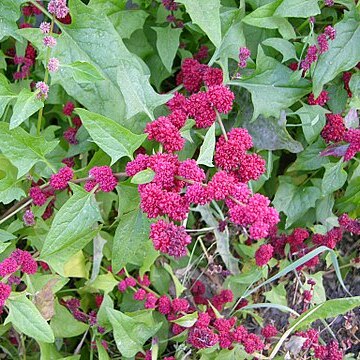Erect or ascending annual 2–6 dm, branched from the base; lower petioles often much exceeding the blades, the upper much shorter; lvs triangular or triangular-hastate, to 10 cm, acute, broadly truncate to an acute base, above the lateral angles entire to coarsely sinuate-dentate; fls in a limited number of globose clusters 5–10 mm thick at anthesis (to 15 mm in fr), these forming a terminal lfless spike, or some also in the upper axils; cal deeply 3-parted, the segments oblong to obovate, concave, at maturity commonly enlarged, fleshy, deliquescent-coalescent, and bright red; seeds erect, dull black, 0.7–0.8 mm wide, narrowly margined; 2n=18. Woodland clearings, often following a fire, and along roadsides in waste places; circumboreal, in our range s. to N.J., Ind., and Mo. (Blitum c.)
An annual plant that looks like "fat hen" in appearance. It grows 20-40 cm high. The stems are smooth and erect. The leaves are alternate and dark-green. The flowers are in round heads without stalks. In the axils of leaves it has red fruit. They are berry-like and juicy.

